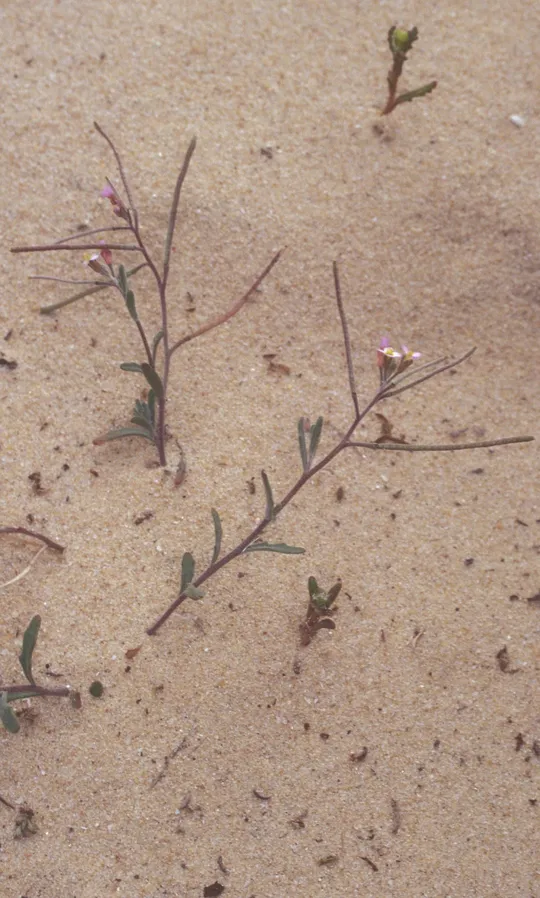Dwarf Maresia
Maresia nana


Maresia nana grows on the
coastal plain in two regions, the Sharon and Pleshet. Fourteen sites were
recorded with certainty, but it is estimated that the species is found at about
20 sites in Israel. In the Sharon, it is located in the area of Caesarea-Hadera
and three other isolated sites: Netanya, Hod HaSharon and the IMI compound. In Pleshet
it is extinct from the Tel Aviv area, where it had been collected several times
in the 1920s and '30s, but survived in Petah Tikva, Kiryat Ono and in the Holon,
Rishon LeZion and Palmahim sands. The southernmost and most isolated site of M. nana in Israel is Ashdod.
Coastal Plain
sands.
The genus Maresia
comprises six species whose distribution is Mediterranean and Saharo-Arabian.
The genus Maresia is close to the genus Malcolmia whose species
grow in the Mediterranean and Saharo-Arabian regions. According to some opinions,
the Maresia species should be included in the genus Malcolmia. M. nana has a miniscule flower and it is a self-pollinator, unlike M. pulchella that has a large flower, blooms abundantly and is cross-pollinated,
and accordingly possess self-incompatibility to prevent fertilization. This
model of annual, small-flowered, self-pollinating species vs. annuals with
brightly colored attractive flowers, as is found in the Brassicaceae family characterize two major and opposite strategies of plants
dealing with parameters of abundance and attractiveness to pollinators and to
herbivorous animals. One typical strategy is having a small number of small
flowers that do not advertise themselves and are not revealed to pollinators or
to herbivores and consequently do not need chemical protection. These flowers
are self-pollinators. The second strategy involves populations forming dense
floral displays in which the flowers invest in advertising with large flowers
and foliage protected from herbivores by chemical means (Kunin and Shmida,
1997). M. nana has "adopted" the first strategy.
·
Maresia nana is found in only
two regions on Israel's coastal plain, at a small number of sites. Most of the populations
that once grew on sites in the Tel Aviv metropolitan area are extinct and the
total number of sites in Israel is on a declining trend.
·
M. nana populations usually occupy
an area of a few hectares and they generally number between hundreds to
thousands of plants.
·
The sandy areas of the coastal plain
are subject to continuous urban expansion, particularly in the Holon and Rishon
LeZion areas – which threatens surviving populations.
·
M. nana is protected in the Sheka
Kesari Nature Reserve and also grows within the boundaries of the Wadil Sorek
National Park. The other sites in Israel are not in declared nature reserves.
·
M. nana is not listed in the
red species of the European Mediterranean countries. No information is
available regarding its status and conservation in other countries.
The known Maresia nana populations should be
monitored to study the long-term survival ability of the species. Areas in the remaining
sandy areas of Holon and Rishon LeZion should be demarcated, to indicate areas
in which the natural vegetation should be protected, including M.
nana populations.
Maresia nana grows on coastal
Mediterranean sands and islands. It is also found on sands of the Black Sea coasts
of Turkey and Bulgaria and was also reported from sandy Caspian Sea beaches in
Iran.
Maresia nana is a
small annual species that grows on the sandy coastal plain at a small number of
sites in the Sharon and Pleshet regions. Urban development in the sandy areas
in central Israel is the major threat to the continued existence of the
populations.
Kunin, B. Shmida, A. 1997. Plant Reproductive Traits as a Function of Local, Regional, and Global Abundance. Conservation Biology 11(1): 183-192.
Current Occupancy Map
| 1000 squre meter pixel | 5000 squre meter pixel | 10000 squre meter pixel | |
|---|---|---|---|
| number of observations | 0 | 0 | 0 |
| in total pixels | 0 | 0 | 0 |
| Family | Brassicaceae |
| Classification | On the endangered species list |
| Ecosystem | Coastal area |
| Chorotype | Mediterranean |
| Conservation Site | Palmahim |
| Rarity |
1
3
6
|
|---|---|
| Vulnerability |
0
3
4
|
| Attractiveness |
0
0
4
|
| Endemism |
0
0
4
|
| Red number |
1
3.7
10
|
| Peripherality | N |
| IUCN category | DD EW EX LC CR EN VU NT |
| Threat Definition according to the red book | Vulnerable |
 Based on:
Based on:






